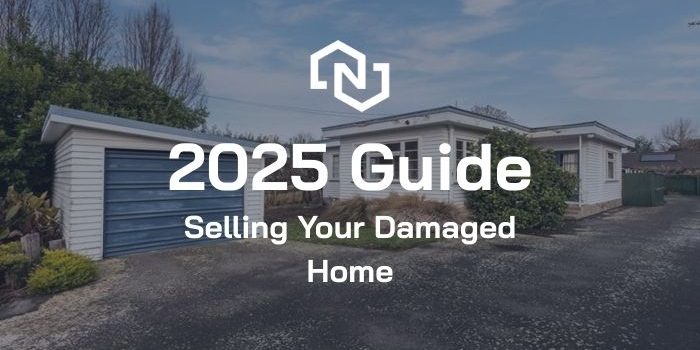Selling a damaged or repair-needed home is stressful. You might be juggling old reports, EQC paperwork, or insurance questions, while trying to make a fair decision for your family. This 2025 guide explains what “as-is, where-is” means, your sale options, what paperwork helps, how offers are calculated, and how a simple as-is sale with My New Start can give you certainty. For more information, in an easy to digest format, download our As-Is, Where-Is Homeowners Guide.
What “as-is, where-is” means
“As-is, where-is” is a legal way to sell a property in its current condition, with buyers expected to do thorough checks before they commit. In practice, it shifts more due-diligence onto the buyer and limits the seller’s warranties about condition. If the home has past EQC claims, there are extra steps like requesting claim information and, where relevant, assigning benefits correctly.
Selling as-is vs repairing first: which fits your life?
Both paths can work. The right choice depends on your time, cash, and stress levels. Use this quick comparison to decide, then sanity-check it against our 3-step process and real seller reviews.
Option 1: Repair, then sell
Repairs can unlock a higher sale price, but you carry the work, costs, and risk until the job is done.
-
Upside: potentially higher price, wider buyer pool, polished presentation.
-
Trade-offs: cash tied up, consents and compliance to manage, build delays or cost over-runs, disruption to daily life.
-
Who this suits: you have spare cash or finance, can manage trades and timelines, and are not in a rush.
Option 2: Sell as-is, where-is (no repairs)
You sell the home in its current condition and pass the work and risk to the buyer.
-
Upside: simple process, no repairs or staging, no open homes, and a fixed settlement date (as agreed with you).
-
Trade-offs: headline price is usually lower than a fully repaired home, and the buyer pool is more specialised.
-
Who this suits: you value certainty, need a clean exit, have limited cashflow, or your insurance claim is unresolved or the home is uninsured.
The money lens: compare “net to you”
Look at what ends up in your pocket, not just the headline price.
Repair, then sell (simplified):
Expected repaired sale price − (repairs + holding costs + marketing + agent commission + risk buffer) = Net to you
Sell as-is (simplified):
Offer based on finished value minus costs and a margin − (your normal legal fees) = Net to you
Not sure? Talk it through with Kane
A five-minute chat can save weeks of second-guessing. Check how our process works or get in touch for a no-pressure chat about your options.
5 benefits of selling as-is, where-is
If repairs feel too hard or too slow, an as-is sale can be the calmer path. You keep costs down, avoid open homes, and set a settlement date that suits your move.
-
No repairs or staging
Skip quotes, consent headaches, and tidy-ups. We buy the home in its current state. Your time and cash stay free for your next place. -
Certainty on timing
We agree a fixed settlement date with you, so you can plan school terms, rentals, or your build. See how our 3-step process works. -
Less stress, fewer people through
One short visit instead of weeks of open homes and conditions. Many sellers prefer the privacy and simple steps. -
Works even if uninsured or the claim is unresolved
As-is suits homes with earthquake or weather damage, no insurance, or stuck claims. If you are unsure we cover your area, check areas we buy. -
Clear numbers, no hidden costs
Our offer is based on the finished value minus costs and a margin. We put it in writing so you can compare your net to you. Read what locals say in reviews.
Ready to talk through your options?
Book a no-pressure chat with Kane via contact us.
5 common risks when selling an as-is, where-is property
1) Lower headline price compared with a repaired sale
As-is homes usually attract a discount because buyers price in work, time, and uncertainty.
How My New Start resolves it: we price from the estimated finished value, then subtract real costs and a fair margin. We explain the numbers in plain English and show what documents can shrink the risk margin, so you can compare the net to you with confidence.
2) Smaller buyer pool and deal fall-throughs
Not all buyers are comfortable with damage, so conditional offers can drag out or collapse.
How My New Start resolves it: we’re a specialist buyer. There are no open homes and usually one short visit before a clear written offer. This cuts time-wasters and reduces fall-through risk.
3) Paperwork and disclosure pitfalls (EQC, LIM, unconsented work)
Missing or unclear records can slow things down or spook buyers.
How My New Start resolves it: we’ll buy as-is even if your file is incomplete. We’ll tell you which items help most (for example LIM, EQC or insurer scopes, engineer/builder reports) and work with your solicitor on any claim assignment required. No pressure, just a straightforward checklist.
4) Settlement timing and move-out stress
If the buyer’s timeline doesn’t fit yours, moving can feel rushed or uncertain.
How My New Start resolves it: we agree a fixed settlement date with you. You deal directly with Kane, so dates are planned around your move, not forced on you.
5) Surprise costs, hidden conditions, or late renegotiations
Some sales come with add-ons and changes that erode your result.
How My New Start resolves it: we make transparent, no hidden-cost offers with clear conditions up front. No agent commissions when you sell direct to us, and no repair or staging costs.
Want to talk through your options? Call 0800 697 827 or email [email protected] for a calm, no-pressure chat.






